Twenty-three Montagnard mercenaries led by Special Forces Sergeants Burton Adams and David Freeman moved quietly through the front gate of the Vinh Thanh Special Forces camp on May 15, 1966, and slipped into the early morning darkness and light fog. Like other patrols sent out over the past week, they were hoping to find anything that would confirm a captured Viet Cong’s claim that a combined North Vietnamese Army/Viet Cong force would soon attack their camp. The patrol members moved to the shores of the Song Con River, climbed into small boats and paddled across the deep river making as little noise as possible. On the other side, they picked up a trail heading northeast toward the high, green mountains shrouded in thick morning clouds. Within several hundred yards, the trail narrowed and became steeper and more heavily vegetated. The night slowly gave way to daylight.

Troops Landed at LZ Hereford for a Critical Mission
The men drew their machetes to cut through the tangle of vines and matted foliage. After three hours of struggling through increasingly steep terrain, they found a well-used trail along a ridge. Adams moved the patrol off the trail and called for a midmorning lunch break. Not a word was spoken as the disciplined men silently dug out their cold rice and dried fish. When everyone had eaten, Adams waved for them to get up, but Dimh Ghim, the “head” Montagnard, motioned the men to stop. He’d heard the muffled voices of enemy soldiers. The patrol quietly split into three groups and each moved out in a separate direction to search for the unseen enemy. Ghim’s group was the first to find them sitting in the shade, taking a break on an adjacent trail. He gestured his men to form a line and gave the signal to fire. Within seconds, five North Vietnamese Army soldiers lay dead. Several dozen others stampeded down the hill, leaving behind their weapons and rucksacks. The men searched the bodies and gear, and on an NVA lieutenant found a hand-drawn map detailing an attack on the Vinh Thanh camp. His notebook indicated that elements from the 2nd Viet Cong/NVA Regiment would attack within a week. A second document specified that an NVA battery of two guns from the 32nd Artillery Battalion would support the attack. Freeman looked up to the top of the mountain. “Up there somewhere are hundreds of Viet Cong and North Vietnamese wanting to bring us a world of hurt,” he said.

With proof that an attack on the camp was imminent, Adams radioed Captain Frank Tinseth, his detachment commander. Tinseth passed the intelligence to his superiors, who notified the 1st Cavalry Division headquarters in An Khe, some 20 miles to the west. Major General John Norton, who had recently taken over command of the division, ordered 1st Brigade commander Colonel John Hennessey to deploy several rifle companies to probe the area where the documents were captured to see if large enemy forces were present.
Early the next morning, May 16, Bravo Company, 2nd Battalion, 8th Cavalry, under the command of Captain J.D. Coleman, assembled at the An Khe airfield to await Huey lift ships. With them was Special Forces Sgt. 1st Class Thomas Welsh, along with his Vietnamese intelligence sergeant and an interpreter. When the first group of six helicopters arrived at midmorning, Coleman and 40 of his men jumped aboard and headed east toward a landing zone in the high mountains of Binh Dinh Province. Soon, all 126 troopers were in the air on the way to LZ Hereford.
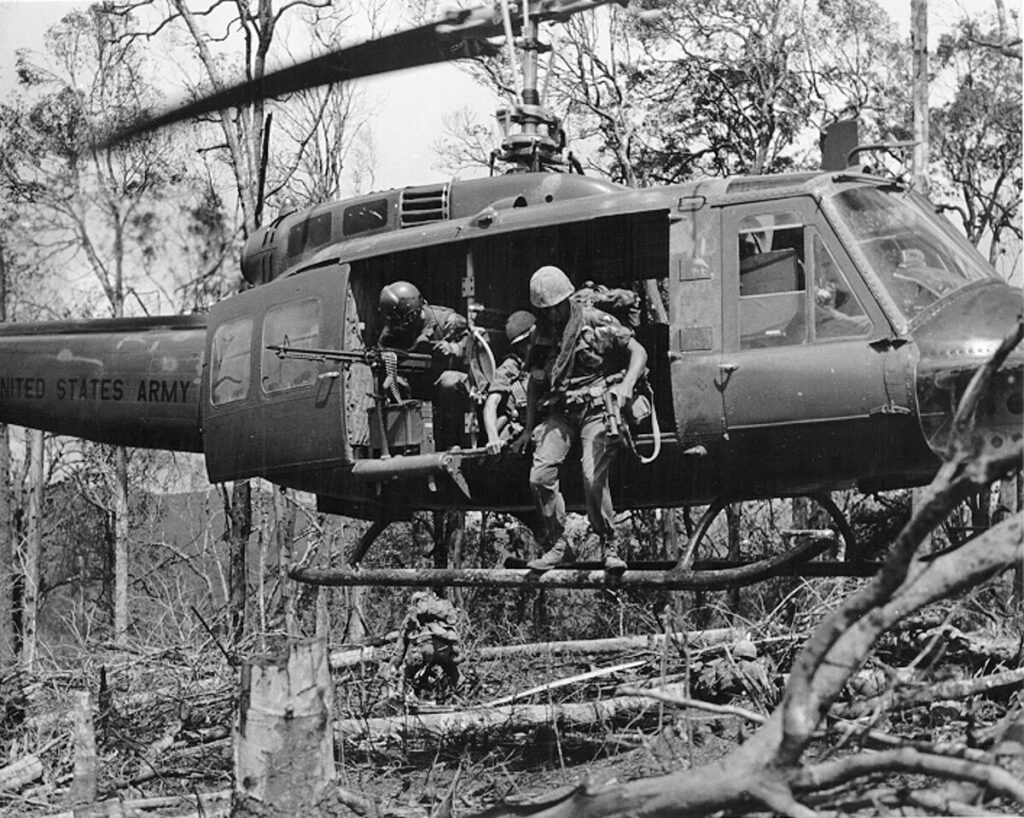
LZ Hereford was a one-ship landing zone: Each helicopter had to drop its men and quickly lift off to make room for the next helicopter. In a little over an hour, all of Coleman’s men were on the ground. At 1100 hours, Bravo Company set off along a wide, well-beaten trail winding upward along the spine of a long, thin ridge. As the trail narrowed farther up the mountain, the heavily laden men struggled through mud and “wait-a-minute” vines and large rocks that made their progress slow and difficult.
A couple of hours into the climb, the point squad led by Staff Sgt. Jerry McCullough ran into some Viet Cong in prepared positions near the top of a small hill. The point man fired, and instantly the enemy fired back, killing him and two other troopers and wounding four. The company column also came under heavy fire. Coleman ordered his platoons to form a company perimeter on a small patch of high ground and radioed the battalion for support and reinforcements.
McCullough’s squad raced back to the perimeter, carrying their wounded. Moments later, the enemy renewed their attack at the same time as a monsoon rainstorm move in, unleashing cold rain. Using the dark, fog and wet conditions to their advantage, the Viet Cong surrounded Bravo with automatic weapons fire from all sides, compressing Coleman’s men into a tighter perimeter. Undaunted, Bravo returned fire through the downpour until the VC finally withdrew. Coleman used the letup to retrieve his dead and wounded. He also received a radio message that a rifle company had landed on LZ Hereford during a break in the weather and would set out to his location once another company arrived to secure the landing zone.
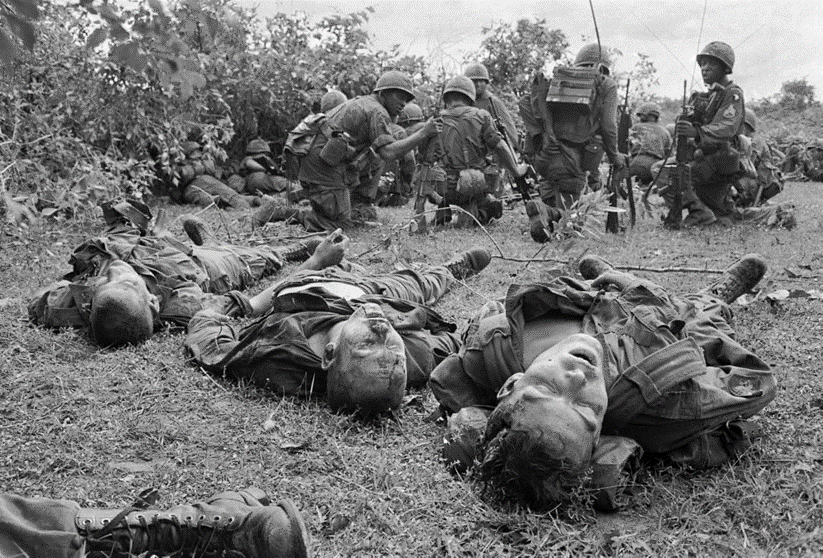
At about 1800 hours, the Viet Cong mounted a major assault, threatening to overrun the company. Coleman received word from his forward observer (FO) that two aerial rocket artillery helicopters were on their way, racing through the rain, fog, and darkness to his position. The gunships, flown by Lt. Col. Morris J. Brady, battalion commander of the 2nd Battalion, 20th Field Artillery, and Major Roger J. Bartholomew, both of whom had volunteered for the dangerous mission, appeared in minutes. Guided by the FO and ground flares, the choppers rolled in with machine guns blazing and 2.75-inch rockets firing, some hitting within feet of the company’s perimeter. The timely fire support made the difference, and by 1930 hours, the enemy had withdrawn. But throughout the night, enemy mortar fire and probing small-arms fire continued to harass the men and inflict casualties.
How Bravo Company Fought at LZ Hereford
Inside the perimeter, 15 men lay dead, 12 from Bravo plus Special Forces Sergeant Welsh and his intelligence officer and interpreter. All three had been shot in the head by a sniper. Thirty men suffered wounds, some life-threatening. Medics tended to their needs while Coleman’s men placed the dead in two rows and covered them with rain-slick ponchos.

That evening, two rifle companies from the 1st of the 12th Cavalry landed at Hereford to reinforce Bravo. Captain John Cummings’ Alpha Company slipped in during a break in the weather and set out to reinforce Bravo once Charlie Company arrived to secure the landing zone. Alpha finally reached the Bravo perimeter around 2200, after a rugged two-hour climb, and took over security from the exhausted men.
Meanwhile, Charlie Company, commanded by Captain Don Warren, took up positions at LZ Hereford in the enemy spider holes scattered throughout the landing zone. Warren ordered his troops to dig the holes wider and deeper. As they dug, a heavy night fog rolled over the entire mountain area, creating an eerie vibe to the already black night.
Just before midnight, the men heard metal against metal sounds in a ravine below them. Warren felt certain the Viet Cong were setting up a mortar tube. Artillery was called in on the suspected enemy position, only to kill two soldiers in a friendly fire incident.
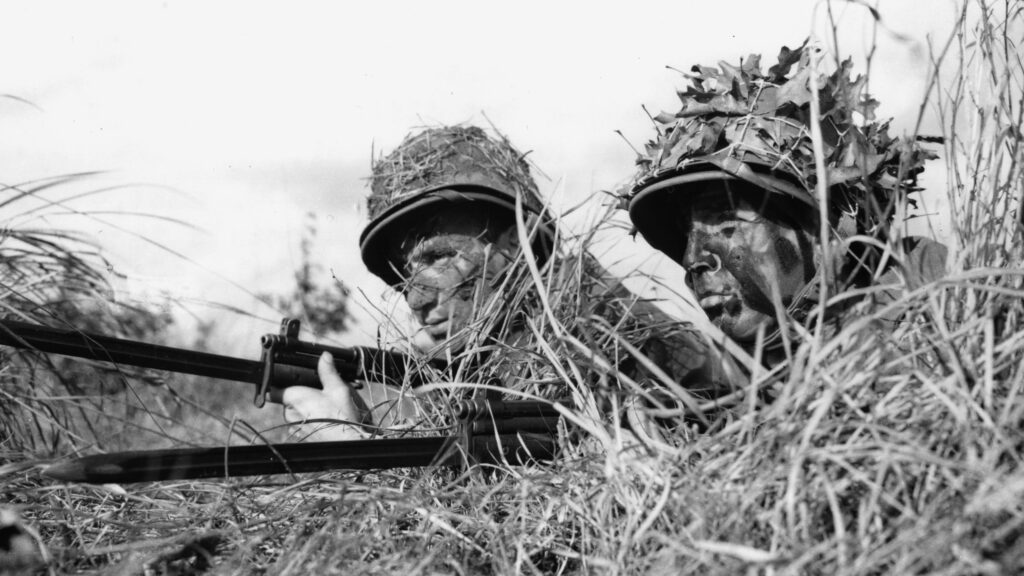
The intensity of the mountain battle convinced General Norton that the 3rd PAVN (People’s Army of North Vietnam) Division’s 2nd PLAF (People’s Liberation Armed Forces) Regiment was in the area, operating east of the Vinh Thanh Valley with a second regiment possibly nearby. To deal with the threat, he launched a multi-battalion sweep, code-named “Operation Crazy Horse” after the Oglala Sioux chief who helped wipe out George Custer‘s 7th Cavalry Regiment at the Battle of the Little Bighorn in 1876.
Ideally, the airmobile infantry would envelop the retreating enemy and block escape routes. Under Norton’s plan, Colonel John Hennessey would press the attack against the VC 2nd Regiment, moving quickly into landing zones north and east of Hereford. Hennessey placed his forward command post at LZ Savoy in the Vinh Thanh Valley on May 17 and brought in rifle companies from Lt. Col. William B. Ray’s 1st Battalion, 5th Cavalry, and the 2nd Battalion, 12th Cavalry, under Lt. Col. Otis C. Lynn. Following Norton’s orders, Hennessey told his two battalion commanders to find the enemy and pursue him “regardless of his direction of movement,” pushing his retreat in a fluid movement that rapid helicopter mobility allowed.
At daybreak on the 17th, mist-covered LZ Hereford as helicopters began delivering Alpha Company, 1-5, to search the area north of the two embattled companies. Under Captain Nick Waddock, Alpha set out to explore the ridge near the site of the previous day’s fighting, leaving its 81mm mortar platoon and one rifle company behind for LZ security. Charlie Company, which had spent the night at LZ Hereford, also headed up the mountain trail toward the two surrounded companies, leaving behind its mortar platoon as well.
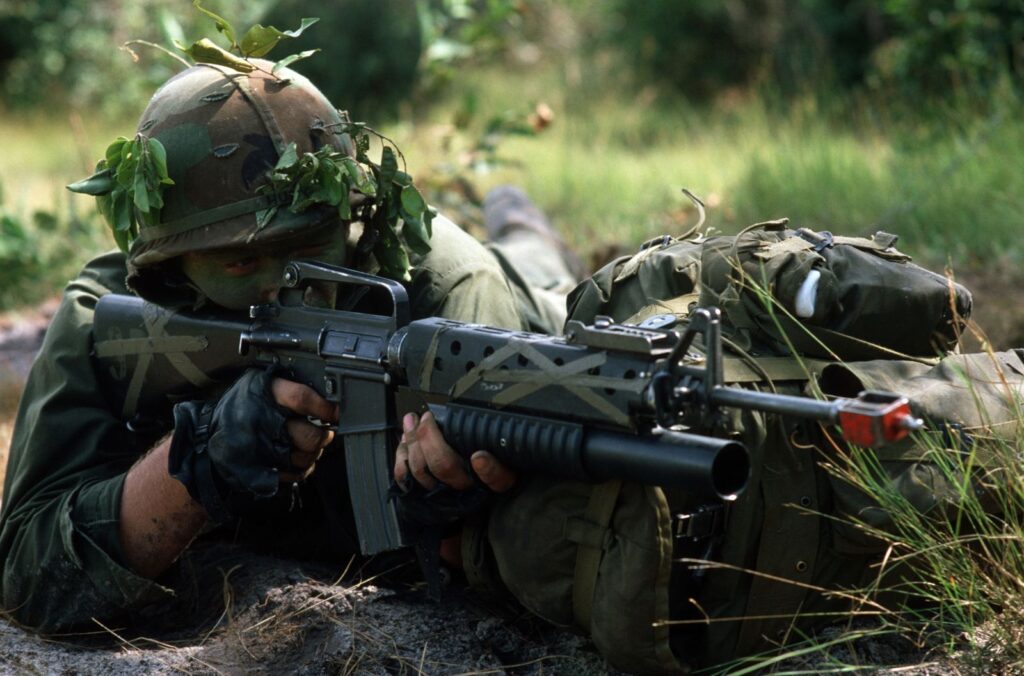
At 0630 hours, inside the perimeter on the mountain, Bravo and Alpha cavalrymen initiated a “mad minute,” firing every weapon they had as fast as they could, hoping to kill any hidden enemy preparing for an assault. Just as the mad minute began, the VC regiment charged. For nearly two hours, the Viet Cong surged out of the jungle at intervals and rushed the foxholes. Casualties mounted, and most of the defenders were nearly out of ammunition. With orders to “fix bayonets,” the Americans waited to be overrun. Then, for no apparent reason, save for their possible awareness of the approach of Ray’s or Warren’s relief forces, the enemy faded away into the lifting fog.
Coleman and Cummings assessed their losses. Bravo had lost 25 killed and 62 wounded. Alpha suffered three killed and 37 wounded. Thirty-eight enemy bodies were scattered within or near the perimeter. They found dead enemy snipers hanging in some of the trees. Evidence indicated an additional 200 soldiers from five NVA battalions and two local VC companies had died in the fight.
Later that day, Bravo Company, 2-8, carried its casualties down the ridge to LZ Hereford and departed for An Khe. Alpha, 1-12, also pulled out, but it remained at the landing zone with Charlie Company. Warren’s men helped Alpha bundle body parts and carried the wounded and dead down the hill to Hereford on stretchers fashioned from ponchos and small tree limbs. As the stretcher-bearers moved down the wet trail, many slipped and fell, spilling casualties into the sticky mud. At LZ Hereford, a helicopter waited to evacuate the most seriously wounded. Other medevacs followed until all the wounded were out.
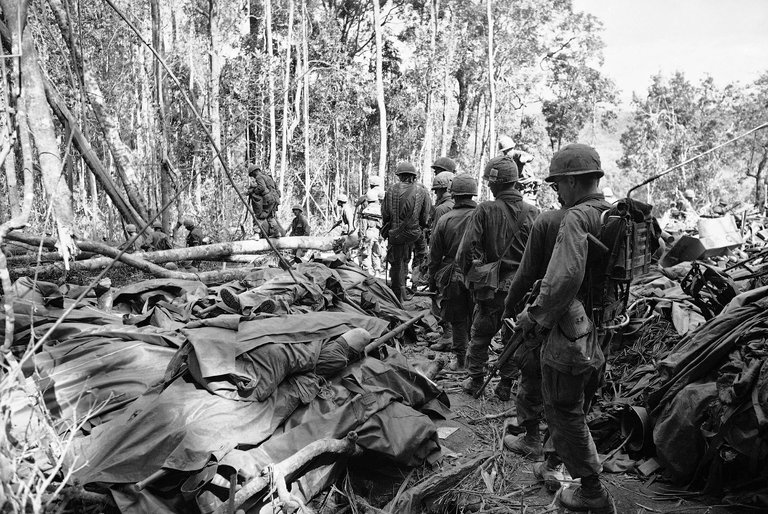
Before a CH-47 Chinook arrived to take out the dead, including the three from the Special Forces camp, Bravo, 1-5, under Captain Joe Beeman, landed on LZ Hereford. Horrified at the sight of so many dead lined up on the ground, the men of B Company couldn’t get off Hereford fast enough. They hastily assembled in a column and began a fast-paced climb up the same well-traveled trail into the battle area, disappearing into the mountain jungle.
When the Chinook arrived, it dropped a cargo net for carrying out the dead. Because of the difficulty getting the wounded and dead out, Col. Hennessey ordered a helicopter platform built on the battle site. Under clear skies for the first time in a week, on May 19 the men began cutting trees and brush. A Chinook lowered combat engineers and equipment, and by the end of the day the engineers, assisted by grunts, had constructed a log platform strong enough for a Chinook to land on. They named it LZ Milton.
When Reinforcements Arrived at LZ Hereford
Late in the evening on May 20, Lt. Col. Rutland Beard, 1st Battalion, 12th Cavalry commander, radioed new missions for Cummings and Warren to begin the next morning. Cummings was to move Alpha directly to LZ Hereford, where it would be airlifted to An Khe to provide perimeter security. Warren’s men would sweep the high ground from LZ Milton to LZ Hereford and scout the lower slopes between the two landing zones. Then they would move down the mountain on a search-and-destroy mission that ended at LZ Savoy in the Vinh Thanh Valley below.

At sunrise the next day, as both rifle companies prepared to leave LZ Milton, a helicopter landed with a hot breakfast for the troops. Also arriving was 31-year-old war correspondent Sam Castan, who was hoping to write stories for Look magazine about grunts experiencing combat. Just before 0900, Cummings’ company started down the trail to LZ Hereford. Thirty minutes later, Warren moved Charlie Company overland in search of the enemy. Castan grabbed a ride on a helicopter, taking some men and equipment to LZ Hereford.
Warren’s company arrived at LZ Hereford around 1200, just as the last of Cummings’ men were lifted off and flown to An Khe. Col. Beard and his operations officer flew in around 1230 to go over Warren’s mission. Beard told the captain to leave his 20-man mortar platoon alone on LZ Hereford to support the company’s movement. Warren argued that his platoon was vulnerable; he wanted to leave behind a rifle squad or two for security. Beard said no before flying off. Reporter Sam Castan stayed with the mortar platoon, which was to be extracted from LZ Hereford in a couple of hours.
At 1330, a scorching sun beat down on Warren’s company as it moved off the LZ into the dense, muggy jungle toward the valley below. Warren radioed back to his mortar platoon periodically requesting reconnaissance fire ahead of the company’s advance, but 30 minutes into the descent, he lost radio contact. The only way he could talk to the mortar platoon was through the artillery fire direction center (FDC) at LZ Savoy.
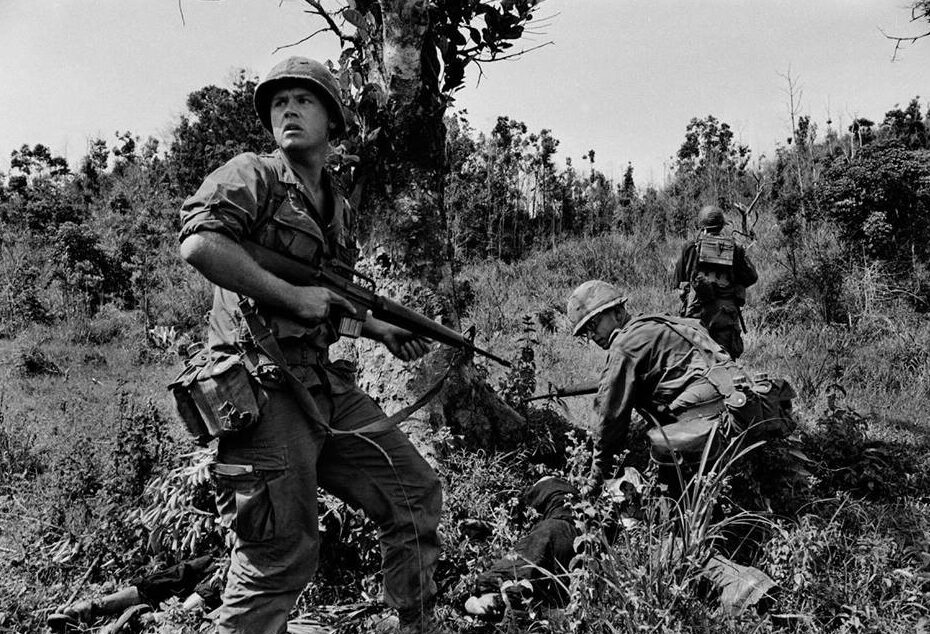
Halfway down the mountain, Warren got a frantic message from the FDC: The mortar platoon was under attack by hundreds of enemy.
He ordered his column back up the hill. Word filtered through the ranks that the mortar platoon was being overrun. Warren pushed his troops to their limits, forcing them to double-time up the hill. Men lost their footing and some dropped from heat exhaustion. M-60 machine gunner Spc. 4 Mickey Sever, overtaken by nausea, dizziness and muscle pain, questioned whether he could make it to the top. But refusing to let his buddies down, he marshaled his strength.
By the time they reached Hereford, it appeared to be deserted. Specialist 4s Ben Dubose and Mel Lewis raced to a foxhole to jump in but stopped at the edge. At the bottom were two bodies torn to pieces by bullets and grenades. Another trooper, Specialist 4 Ivory Whitaker, anxiously moved from foxhole to foxhole, hoping to find his cousin, Pfc Henry Benton. When he found him, it was too late; the sight of his mutilated body made him sick. Specialist 4 Jim Braga and many of Warren’s troopers, still horror-stricken from picking up the body parts of strangers in the battle area the day before, we’re unable to look at the corpses of men they knew personally.
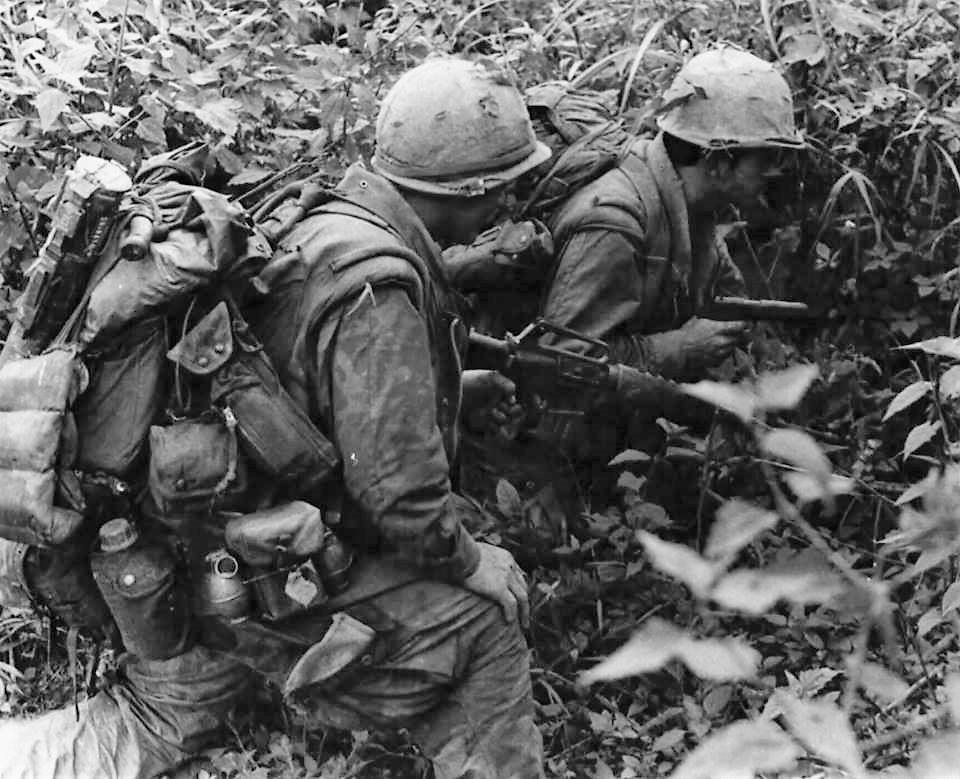
With security established around the landing zone, Captain Warren put his men on a detail to identify and place body parts in individual body bags. Most of the 13 dead were unidentifiable. He ordered a search for nine other men whose whereabouts were unknown. Some of them were found at the edge of the perimeter. In searching other areas, the troopers found Sam Castan’s body down the hill. Three survivors who had managed to escape and evade the slaughter returned to the now-secured hill. By midafternoon all the bodies were evacuated. (For a detailed account of what happened to Warren’s mortar platoon at Hereford, see “Last Stand at LZ Hereford,” in the October 2012 issue.)
The Story Behind the Harrowing Last Stand
Around 1730 hours, Warren resumed his company’s march to the valley. Midway down, he stopped to cut loose a squad that earlier he’d ordered to occupy a hill overlooking the abandoned landing zone and set up a “stay-behind” ambush. When the squad observed a half-dozen flashlights bobbing through the jungle and onto LZ Hereford, Charlie ordered the artillery FDC to “fire at will” on pre-planned targets. Soon 105mm rounds screamed in, blasting the hill and the NVA/VC on it. The squad reached the extraction point and radioed for the pickup.
A single Huey shattered the quiet and landed. Troopers scrambled onto it, but with such a heavy load the chopper couldn’t lift off. The men looked at each other and decided that if all of them couldn’t get out, no one would go. They departed for LZ Savoy the following morning.
On May 20, General Norton ordered the 1st Battalion, 8th Cavalry, commanded by Lt. Col. Levin B. Broughton, to commit several rifle companies. The following day, Bravo and Charlie companies, 1-8, departed LZ Horse in the early morning hours and headed northeast in search of elements of the 22ndVC/NVA Regiment that were thought to be hiding in the mountains. Bravo, under Captain Ray Martin, guided along the south side of a stream, while Charlie, commanded by Captain William Mozey, covered the north side. Signs everywhere indicated the enemy’s presence. Moving forward, Bravo encountered a large force.
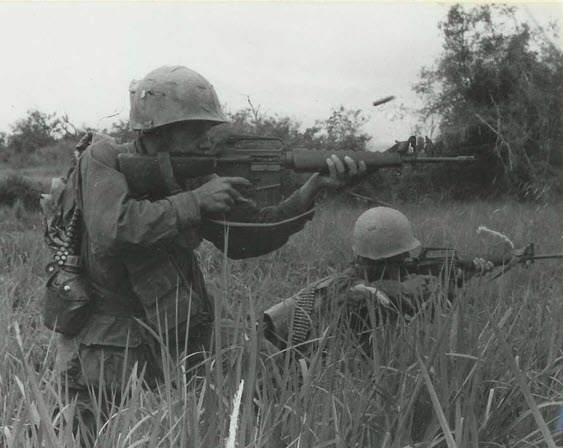
Charlie Company found recently abandoned enemy bunkers in which to hide and fired on the enemy to support Bravo. Fighting continued into the afternoon, but by nightfall, the Viet Cong had withdrawn northwest to prepared hillside positions. Bravo made a wide swing in the dark around the enemy’s bunkers and moved up the hill, opposite where the VC were expecting resistance. With all his men in place, Martin radioed Mozey to shift his fire away from the enemy bunkers. As the fire lifted, Martin expertly executed a bold plan of scrambling downhill, throwing grenades into the bunkers and shooting any exposed enemy. Some defenders fled into the night, but at least 60 lay dead. A few Americans were also killed or wounded.
Believing the 1st Brigade was suffering too many casualties, General Norton changed strategy on May 26. Rather than have American forces seek out the enemy in the unforgiving mountainous terrain, he ordered Col. Hennessey to stop search-and-destroy operations and to surround the battlefield in blocking positions while B-52 airstrikes and artillery pounded the enemy contained in the circle. He reasoned that if the enemy stayed in place, they would suffer numerous casualties. If they tried to break out en masse, American troops, augmented by South Korean and South Vietnamese forces, would block their escape routes. Still, many eluded the trap.
By early June, all signs pointed to large enemy units having moved out of the area, leaving behind only small teams to delay and harass the Americans while the main body withdrew. On June 5, after 21 days of fighting in the mountain wilderness of central Binh Dinh Province, Operation Crazy Horse was over.
The last 1st Cavalry troops were airlifted out and taken to endless battles to fight.
Michael Christy served in the 5th Special Forces Group in Vietnam in 1967-68. In 1970 he commanded C Company, 1st Battalion, 12th Cavalry Regiment, 1st Cavalry Division (Airmobile), and served as 3rd Brigade assistant operations officer. He has worked in the entertainment industry since retiring from the Army.
Read About Other Battlefield Chronicles
If you enjoyed learning about the LZ Hereford, we invite you to read about other battlefield chronicles on our blog. You will also find military book reviews, veterans’ service reflections, famous military units and more on the TogetherWeServed.com blog. If you are a veteran, find your military buddies, view historic boot camp photos, build a printable military service plaque, and more on TogetherWeServed.com today.
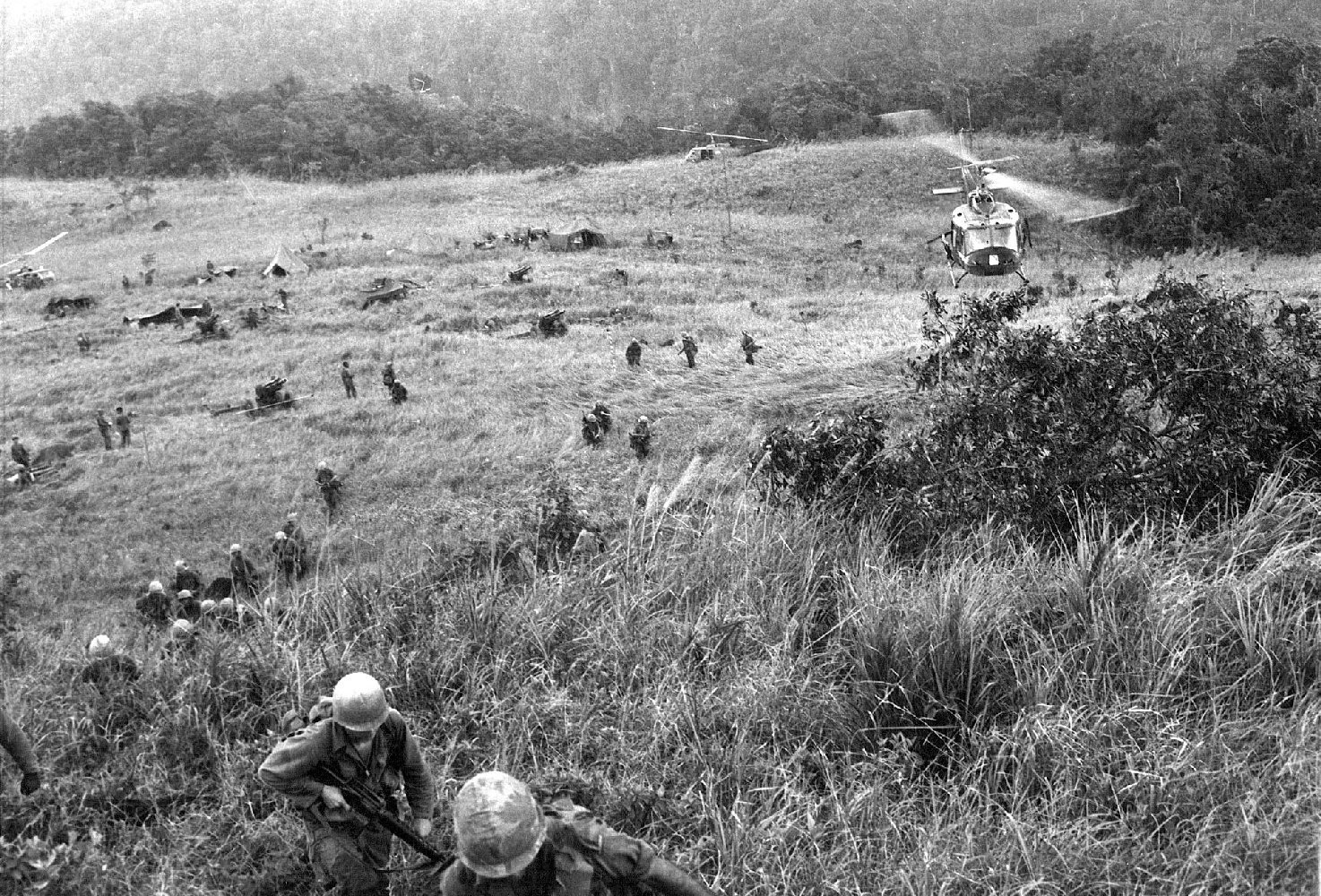
I served as an air assault Sky Trooper Combat Infantry Medic,1st Calvary Division (airmobile) A Company 1st Battalion 5th Regiment. I remember.